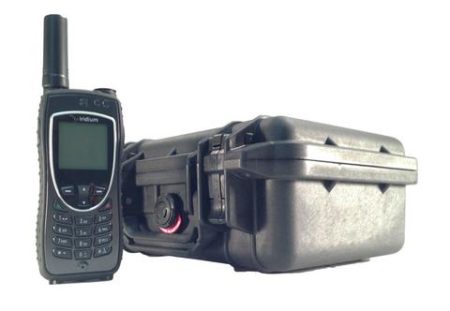
December 25, 2019 – The original cellular phone was shaped an elongated brick with an extended antenna. Ungainly looking the technology quickly evolved into much smaller and sleeker form factors as batteries got smaller while screens got larger. From clamshell-styled communicators that eerily resembled the technology depicted on Star Trek to today’s smartphones, the evolution of the technology in less than four decades has been remarkable. But not so much with phones using satellite networks. They still bear a remarkable resemblance to that first cellphone brick that arrived on the scene in 1973.
In the last couple of weeks Iridium, the satellite network communication company introduced its latest model to the public. The Iridium 9575 Extreme doesn’t look like much when you are thinking about the ergonomics of today’s cellphone models. The model I saw was black, had a very large external antenna, and the screen was positively tiny. But this phone can do some remarkable things. For one it can connect to 66 satellites circling nearly 800 kilometers (500 miles) above the Earth. The Iridium satellite network has been placed in polar orbits meaning the phones can communicate anywhere on the planet. The low orbit also means communication is instantaneous with no latency (no signal delay other than an occasional downlink connectivity handoff hiccup).
The phone features an alphanumeric keypad that harkens back to earlier cellphones. There is no room for a QWERTY keyboard on the hardware or the screen. That means sending text messages requires a mastery of the nine-numeral letter positions. The screen does provide some information on its monochrome display including status, signal strength, number dialed and menu items. The phone includes GPS tracking. Its antenna can be extended from a retracted position to improve reception and transmission. The battery keeps a charge for several days in standby mode and allows for continuous talk up to four hours. And if you are looking for rugged, this phone is designed to take abuse. It is shock, dust, and high-pressure water-resistant.
When you first turn it on the phone looks for the closest Iridium satellite and locks onto it displaying the connection on screen. You can then place a call anywhere on the planet without having to pay any extra wireless charges as the satellite network makes the downlink connections on your behalf. The phone features its own area code and dialing numbers in any country requires you to put the area code of that locale in before the local number.
Like all mobile phones, Iridium comes with standard power adapters, a charger, and a carrying case. An accessory kit provides all kinds of additional functionality that could prove useful to a remote traveler including the ability to connect the phone to an external vehicle antenna, or a magnetic vehicle antenna that can be placed on a vehicle roof, a set of hands-free headphones, and some other neat accessories.
So when would you need to use a satellite phone over conventional mobile technology?
These phones are designed to meet the needs of those who find themselves with little access to traditional cellphone networks. Typically they are purchased by energy companies, forestry companies, park services, search and rescue organizations, the coast guard, military, and other government institutions.
But if your work involves communicating from inside a building, then you will need a cellphone because the satellite phone will not work. Nor will it work easily in a densely crowded downtown core where high-rise buildings can block the signal. The same is true in a densely treed forest. Why is this? Because satellite phones need access to the sky and the horizon at all times.
Other than that, the phones are powerful tools that can provide voice, text, and even email communication (although in the case of the latter the lack of QWERTY keyboard interface has its limitations).
What about the coverage provided by the Iridium network?
Back in March, I wrote about the deployment of global satellite networks covering a number of providers. At the time Iridium was the first to complete its deployment of 66 satellites not including spares capable of providing global coverage without the need for a ground-based network. Iridium could keep its users connected from the poles to the most isolated areas on the ocean. The one place you won’t need a satellite phone is talking to the crew on the International Space Station (ISS). ISS has used radio as its traditional means of staying connected to Earth ground stations. It may soon replace radio with an optical technology by the names of OPALS. But that’s a subject for a future blog posting.
So if you are one of those in the need of a satellite phone, you probably won’t go wrong in choosing the Iridium network and its latest Iridium 9575 Extreme model. It may not have the bells and whistles of your Apple or Android smartphone, but in a pinch, you’ll never lose connectivity. Just remember to stay outside and away from tall buildings and trees when placing a call.









